steering PONTIAC FIREBIRD 1996 Owners Manual
[x] Cancel search | Manufacturer: PONTIAC, Model Year: 1996, Model line: FIREBIRD, Model: PONTIAC FIREBIRD 1996Pages: 386, PDF Size: 19.18 MB
Page 28 of 386

AIR
BAG
There is an air bag
readiness light on the
instrument panel, which
shows AIR BAG.
How the Air Bag System Works
The system checks the air bag’s electrical system for
malfunctions. The light tells
you if there is an electrical
problem. See “Air Bag Readiness Light” in the Index
for more information.
Where is the air bag?
The driver’s air bag is in the middle of the steering whee\
l.
1-21
ProCarManuals.com
Page 29 of 386
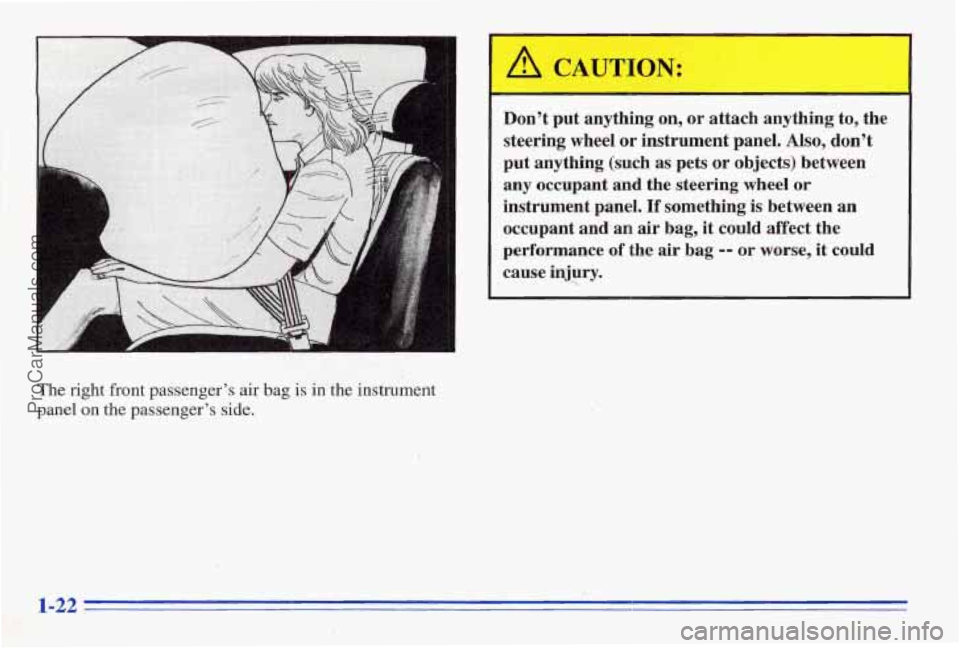
A
A
The right front passenger's air bag is in the instrument
panel on the passenger's side.
I
Don't put anything on, or attach anything to, the
steering wheel
or instrument panel. Also, don't
put'anything (such as pets or objects) between
any occupant and the steering wheel or
instrument, panel.
If something is between an
oc-cupant and an air bag, it could affect the
performance
of the air bag -- or worse, it could
cause injury.
ProCarManuals.com
Page 30 of 386
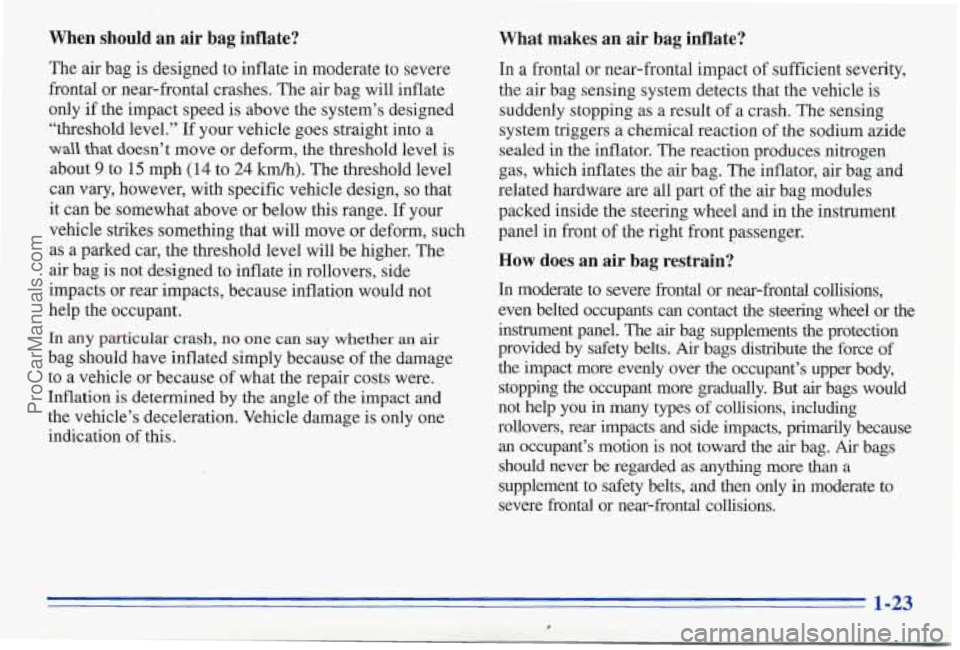
When should an air bag inflate?
The air bag is designed to inflate in moderate to severe
frontal or near-frontal crashes. The air bag will inflate
only
if the impact speed is above the system’s designed
“threshold level.”
If your vehicle goes straight into a
wall that doesn’t move or deform, the threshold level is
about 9 to 15 mph (14 to 24 km/h). The threshold level
can
vary, however, with specific vehicle design, so that
it can be somewhat above or below this range. If your
vehicle strikes something that will move or deform, such
as
a parked car, the threshold level will be higher. The
air bag is not designed
to inflate in rollovers, side
impacts or rear impacts, because inflation would not
help the occupant.
In any particular crash, no one can say whether an air
bag should have inflated simply because of the damage
to a vehicle or because
of what the repair costs were.
Inflation is determined by the angle
of the impact and
the vehicle’s deceleration. Vehicle damage
is only one
indication
of this.
What makes an air bag inflate?
In a frontal or near-frontal impact of sufficient severity,
the air bag sensing system detects that the vehicle
is
suddenly stopping as a result of a crash. The sensing
system triggers
a chemical reaction of the sodium azide
sealed in the inflator. The reaction produces nitrogen
gas, which inflates the air bag. The inflator, air bag and
related hardware are all part
of the air bag modules
packed inside the steering wheel and
in the instrument
panel in front of the right front passenger.
How does an air bag restrain?
In moderate to severe frontal or near-frontal collisions,
even belted occupants can contact the steering wheel
or the
instrument panel. The
air bag supplements the protection
provided by
safety belts. Air bags distribute the force of
the impact more evenly over the occupant’s upper body, stopping the occupant more gradually. But
air bags would
not help you in many types
of collisions, including
rollovers, rear impacts and side impacts, primarily because an occupant’s motion is not toward the
air bag. Air bags
should never be regarded
as anythmg more than a
supplement to safety belts, and then only in moderate to
severe frontal or near-frontal collisions.
1-23
ProCarManuals.com
Page 31 of 386
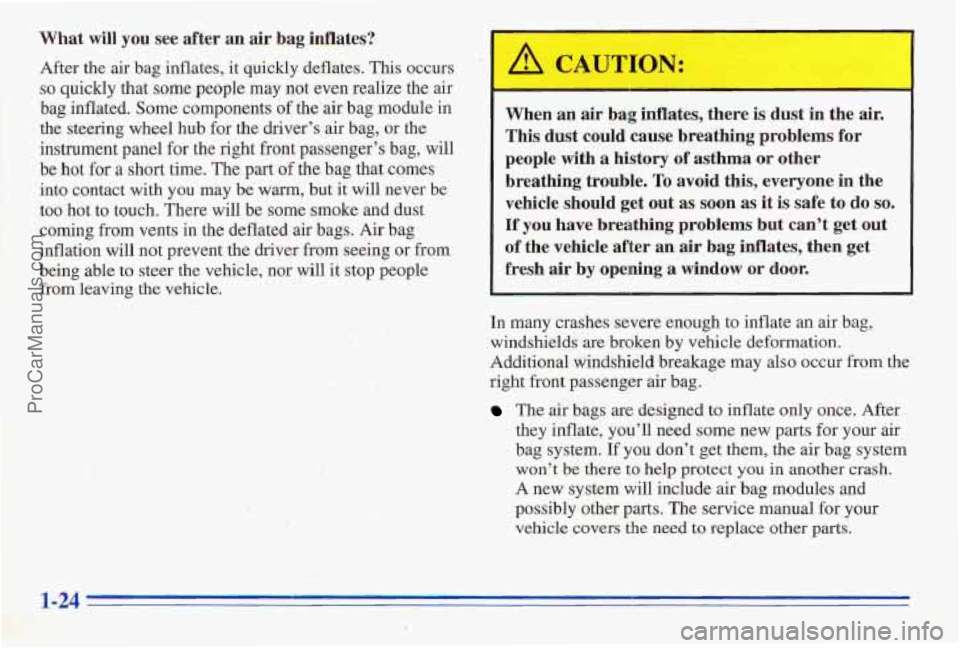
What will you see after an air bag inflates?
After the air bag inflates, it quickly deflates. This occurs
so quickly that some people may not even realize the air
bag inflated. Some components
of the air bag module in
the steering wheel hub for the driver’s air bag, or the
instrument panel for the right front passenger’s bag, will
be hot for a short time. The part
of the bag that comes
into contact with you may
be warm, but it will never be
too hot to touch. There will be some smoke and dust
coming from vents in the deflated air bags. Air bag
inflation will not prevent the driver from seeing or from
being able to steer the vehicle, nor will it stop people
from leaving
the vehicle.
I A CAUTION:
When an air bag inflates, there is dust in the air.
This dust could cause breathing problems for
people with a history
of asthma or other
breathing trouble.
To avoid this, everyone in the
vehicle should get out as soon
as it is safe to do so.
If you have breathing problems but can’t get out
of the vehicle after an air bag inflates, then get
fresh air by opening
a window or door.
In many crashes severe enough to inflate an air bag,
windshields are broken by vehicle deformation.
Additional windshield breakage may also occur from the
right front passenger air bag.
The air bags are designed to inflate only once. After
they inflate, you’ll need some new parts for your air
bag system. If
you don’t get them, the air bag system
won’t be there to help protect you in another crash.
A new system will include air
bag modules and
possibly other parts. The service manual for your
vehicle covers
the need to replace other parts.
1-24
ProCarManuals.com
Page 32 of 386

0
0
Your vehicle is equipped with a crash sensing and
diagnostic module, which records information
about the air bag system.
The module records
information about the readiness of the system,
when the sensors are activated and driver’s safety
belt usage at deployment.
Let only qualified technicians work
on your air bag
system. Improper service can mean that your air
bag system won’t work properly. See your dealer
for service.
~~
NOTICE:
If you damage the cover for the driver’s or the
right front passenger’s air bag, they may not
work properly. You may have to replace the air
bag module in the steering wheel or both the
air
bag module and the instrument panel for the
right front passenger’s air bag.
Do not open or
break the air bag covers.
Servicing ,Your Air Bag-Equipped Pontiac
Air bags affect how your Pontiac should be serviced.
There are
parts of the air bag system in several places
around your vehicle. You don’t want the system to
inflate while someone is working on your vehicle. Your
Pontiac dealer and the Firebird Service
Manual have
information about servicing your vehicle and the air bag
system.
To purchase a service manual, see “Seririce and
Owner Publications” in the Index.
I A CAUTION:
II
For up to 10 minutes after the ignition key is
turned off and the battery is disconnected, an air
bag can still inflate during improper service. You
can be injured if you are close to an air bag when
it inflates. Avoid wires wrapped with yellow tape
or yellow connectors. They are probably part of
the
air bag system. Be sure to follow proper
service procedures, and make sure’ the person
performing work for you is qualified to do
so.
’he air bag system does not need regular maintenance.
ProCarManuals.com
Page 60 of 386
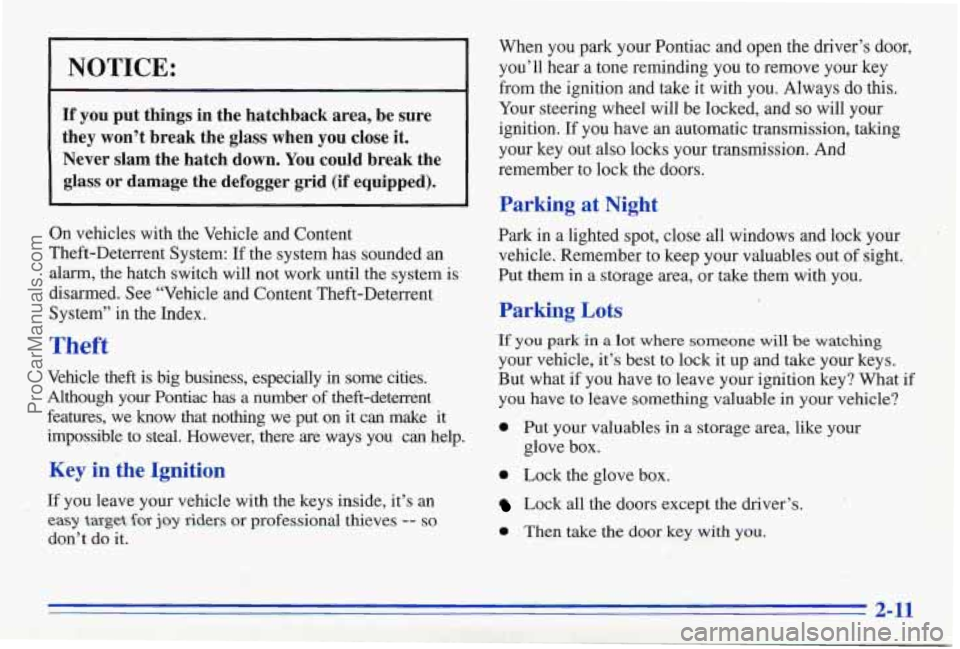
NOTICE:
If you put things in the hatchback area, be sure
they won’t break the glass when you close it.
Never slam the hatch down.
You could break the
glass
or damage the defogger grid (if equipped).
On vehicles with the Vehicle and Content
Theft-Deterrent System: If the system has sounded an
alarm, the hatch switch will not work until the system is
disarmed. See “Vehicle and Content Theft-Deterrent
System” in the Index.
Theft
Vehicle theft is big business, especially in some cities.
Although your Pontiac has a number
of theft-deterrent
features, we
know that nothing we put on it can make it
impossible to steal. However, there
are ways you can help.
Key in the Ignition
If you leave your vehicle with the keys inside, it’s an
easy tmget for joy riders or professional thieves -- so
don’t do it. When you
park your Pontiac and open the driver’s door,
you’ll hear a tone reminding
you to remove your key
from the ignition and take it with you.
Always do this.
Your steering wheel will be locked, and so will your
ignition. If you have an automatic transmission, taking
your key
out also locks your transmission. And
remember to lock the doors.
Parking at Night
Park in a lighted spot, close all windows and lock your
vehicle. Remember to keep your valuables out of sight,
Put them in a storage area,
or take them with you.
Parking Lots
If you park in a lot where someone will be watching
your vehicle, it’s best to lock it up and take your keys.
But what if you have to leave your ignition key? What
if
you have to leave something valuable in your vehicle?
0 Put your valuables in a storage area, like your
0 Lock the glove box.
Lock all the doors except the driver’s.
0 Then take the door key with you.
glove box.
2-11
ProCarManuals.com
Page 71 of 386
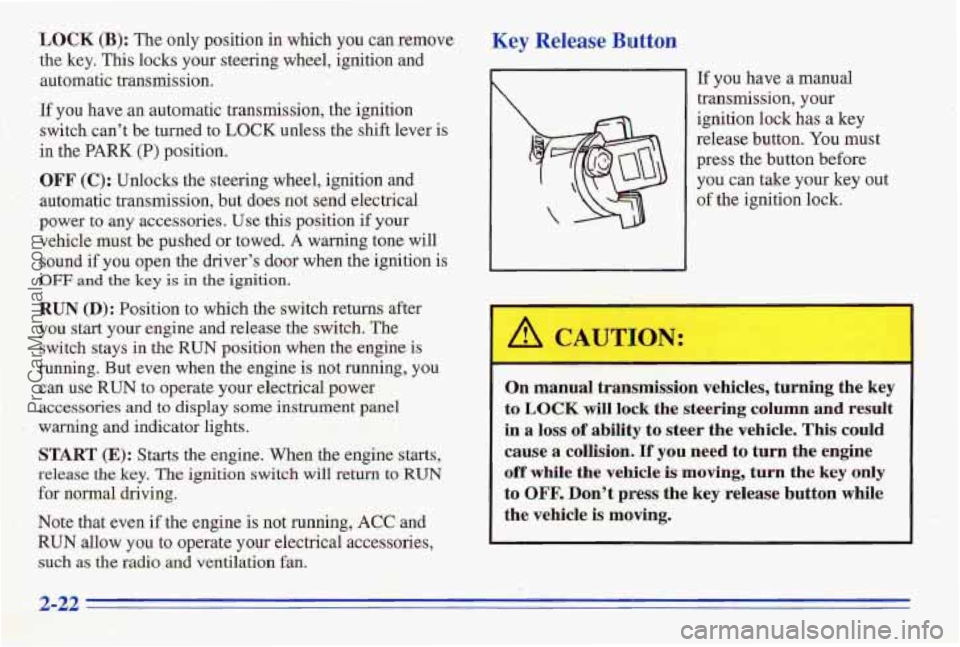
LOCK (B): The only position in which you can remove
the key.
This locks your steering wheel, ignition and
automatic transmission.
If you have an automatic transmission, the ignition
switch can't be turned to
LOCK unless the shift lever is
in the PARK (P) position.
OFF (C): Unlocks the steering wheel, ignition and
automatic transmission, but does not
send electrical
power
to any accessories. Use this position if your
vehicle must be plashed or towed. A warning tone will
sound
if you open the driver's door when the ignition is
OFF and the key is in the ignition.
RUN (D): Position to which the switch returns after
you start your engine and release. the switch. The
switch stays in
the RUN position when the engine is
running. But even when the engine is not running, you
can use RUN to operate your electrical power
accessories and to display some instrument panel
START (E): Starts the engine. When the engine starts,
release the key. The ignition switch will return to RUN
for normal driving.
Note that even if the engine is not running,
ACC and
RUN allow you to operate your electrical accessories,
such as the radio .and ventilation fan.
I warning and indicator lights.
Key Release Button
If you have a manual
transmission, your
ignition lock has
a key
release button. You
must
press the button before
you can take your key out
of the ignition lock.
On manual transmission vehicles, turning the key
to
LOCK will lock the steering column and result
in a loss of ability to steer the vehicle. This could
cause a
collision. If you need to turn the engine
off while the vehicle is moving, turn the key only
to OFF. Don't press the key release button while
the vehicle
is moving.
ProCarManuals.com
Page 72 of 386
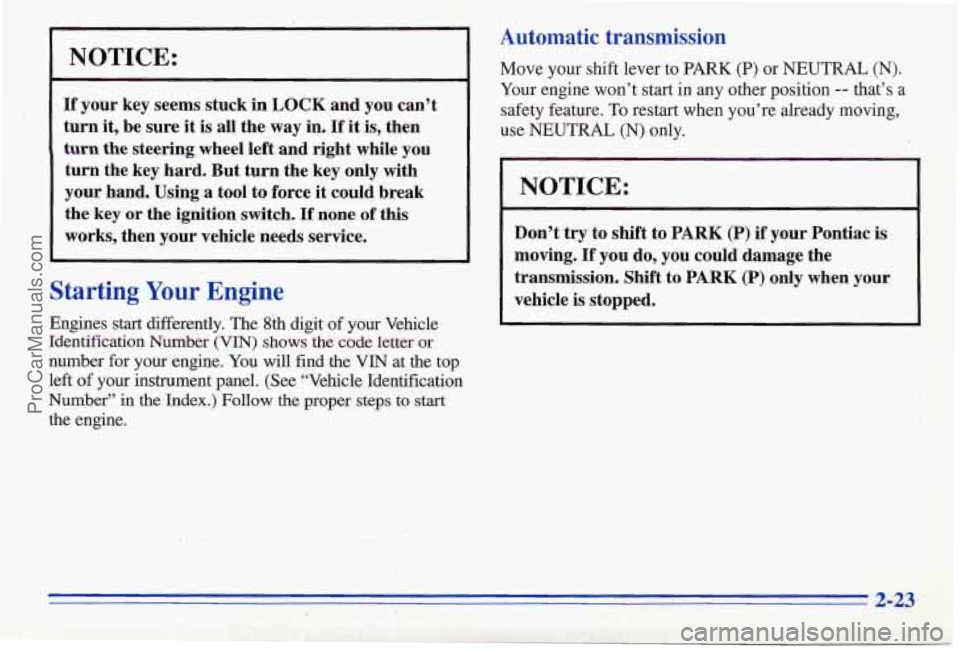
NOTICE:
If your key seems stuck in LOCK and you can’t
turn
it, be sure it is all the way in. If it is, then
turn the steering wheel left and right while you
turn the key hard. But turn the key only with
your hand. Using
a tool to force it could break
the key or the ignition switch.
If none of this
works, then your vehicle needs service.
Starting Your Engine
Engines start differently. The 8th digit of your Vehicle
Identification Number
(VIN) shows the code letter or
number for your engine. You will
find the VIN at the top
left of your instnzment panel. (See “Vehicle Identification
Number” in the Index.) Follow
the proper steps to start
the engine.
Automatic transmission
Move your shift lever to PARK (P) or NEUTRAL (N).
Your engine won’t start in any other position -- that’s a
safety feature. To restart when you’re already moving,
use NEUTRAL
(N) only.
NOTICE:
Don’t try to shift to PARK (P) if your Pontiac is
moving. If you do, you could damage the
transmission. Shift to PARK
(P) only when your
vehicle
is stopped.
2-23
ProCarManuals.com
Page 91 of 386
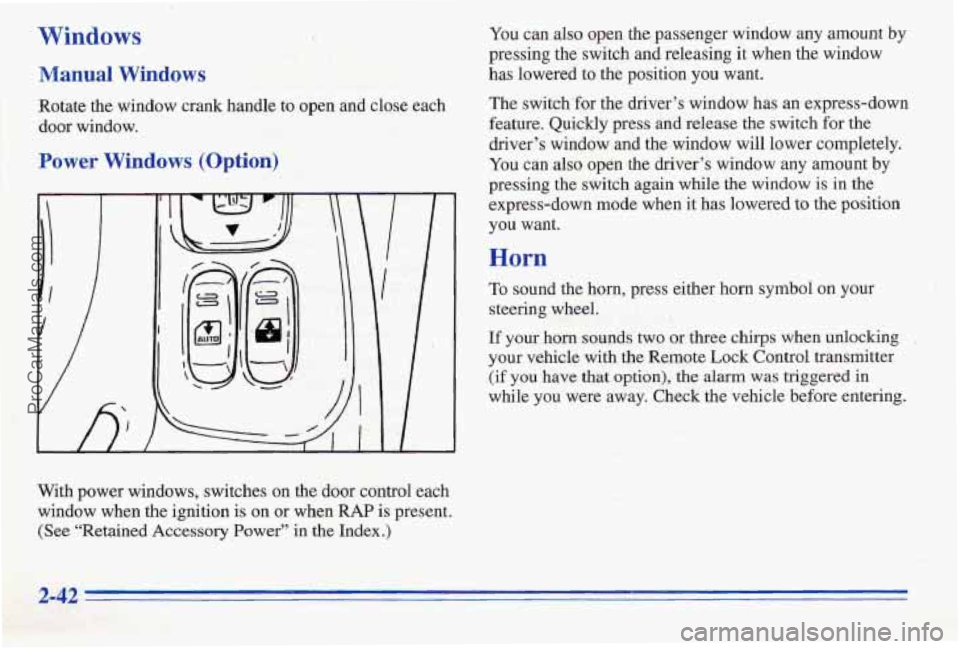
Windows
Manual Windows
Rotate the window crank handle to open and close each
door window.
Power Windows (Option)
T
With power windows, switches on the door control each
window when the ignition is on or when
RAP is present.
(See “Retained
Accessory Power” in the Index.)
You can also open the passenger window any amount by
pressing the switch and releasing it when the window
has lowered to the position
you want.
The switch-for the driver’s window has anexpress-down
feature. Quickly press and release
the switch for the
driver’s window and
the window will lower completely.
You can also open the driver’s window any amount by
pressing the switch again while the
window is in the
express-down mode when it has lowered to
the position
you want.
Horn ..
To sound the horn, press either horn symbol on your ‘ -. ”’ .
steering wheel.
If your horn sounds two or three chirps when unlocking ,
your vehicle with the Remote Lock Control transmitter
(if
you have that option), the alarm was triggered in
while
you were away. ‘Check the vehicle before entering.
.. .., c ’ .I .. I’ .. . ..
2-42
ProCarManuals.com
Page 92 of 386
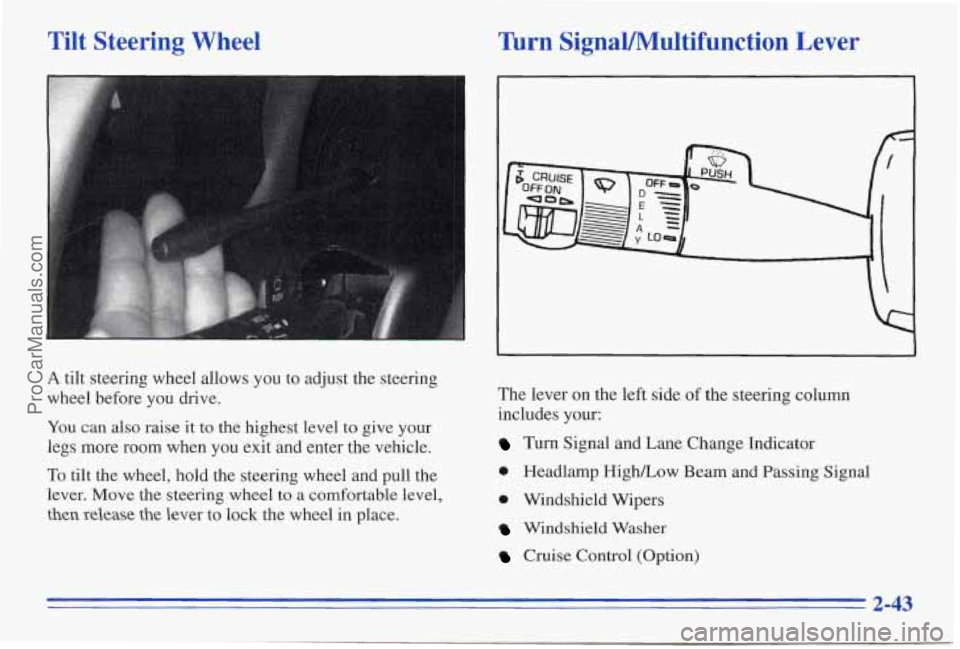
Tilt Steering Wheel Turn SignaVMultifunction Lever
A tilt steering wheel allows you to adjust the steering
wheel before
you drive.
You can also raise it to the highest level to give your
legs more room when you exit and enter the vehicle.
To tilt the wheel, hold the steering wheel and pull the
lever. Move the steering wheel
to a comfortable level,
then release the lever to lock the wheel in place. The
lever on the left side of the steering column
includes your:
Turn Signal and Lane Change Indicator
e Headlamp Highkow Beam and Passing Signal
e Windshield Wipers
Windshield Washer
Cruise Control (Option)
2-43
ProCarManuals.com